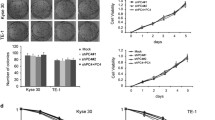Abstract
The aim of this study was to evaluate the changes in radiosensitivity of radioresistant esophageal cancer cells (TE-1R) after disruption of replication protein A (RPA) expression and to explore the potential mechanism. A radioresistant human esophageal cancer cell line TE-1R was established by treating TE-1 cells with the radiation. Then, siRPA1 or -2 was transfected to TE-1R cells. The untransfected group (control) and nonsense short interfering RNA (siRNA) transfected group (NC) were used as controls. To investigate the radiosensitivity changes of TE-1R cells, the dose–survival curve was established by colony-forming assay, and the cell cycle distribution was measured by flow cytometry. (1) Comparing with control and NC groups, the protein expression of RPA1 and -2 decreased significantly 48 h after siRPA1 or -2 transfection. (2) The D 0, D q, and SF2 values reduced from 2.09, 1.70, and 0.85 in NC group to 1.67, 0.71, and 0.44 and 1.82, 0.89, and 0.51 in siRNA1 and siRPA2 transfected groups, respectively. The D q sensitization enhancement ratios (SERDq) were 2.39 and 1.91 in siRNA1 and siRPA2 transfected groups, respectively. (3) The G2/M arrest was significantly caused by siRPA1 or -2 transfection as compared with that in the NC group (t value was 2.827, 2.853, p < 0.05). Post transcriptional silencing of RPA1 or -2 via RNAi can enhance the radiosensitivity of human esophageal cancer cells TE-1R, and the potential mechanism may be related to the inhibition of post-radiation sublethal damage repair and the halted cell cycle progression at G2/M phase. Therefore, RPA may become a new target for radiosensitization enhancement in esophageal cancer.


Similar content being viewed by others
References
Wold, M. S. (1997). Replication protein A: A heterotrimeric, single-stranded DNA-binding protein required for eukaryotic DNA metabolism. Annual Review of Biochemistry, 66(1), 61–92.
Erdile, L. F., Heyer, W. D., Kolodner, R., et al. (1991). Characterization of a cDNA encoding the 70-kDa single-stranded DNA-binding subunit of human replication protein A and the role of the protein in DNA replication. Journal of Biological Chemistry, 266(3), 12090–12098.
Erdile, L. F., Wold, M. S., & Kelly, T. J. (1990). The primary structure of the 32-kDa subunit of human replication protein A. Journal of Biological Chemistry, 265(6), 3177–3182.
Zou, Y., Liu, Y., Wu, X., et al. (2006). Functions of human replication protein A (RPA): From DNA replication to DNA damage and stress responses. Journal of Cellular Physiology, 208(2), 267–273.
Ogawa, R., Ishiguro, H., Kuwabara, Y., et al. (2008). Identification of candidate genes involved in the radiosensitivity of esophageal cancer cells by microarray analysis. Diseases of the Esophagus, 21(4), 288–297.
Bochkareva, E., Korolev, S., Lees-Miller, S. P., et al. (2002). Structure of the RPA trimerization core and its role in the multistep DNA-binding mechanism of RPA. EMBO Journal, 21(7), 1855–1863.
Yu, D., Zhou, C., & Tian, Y. (2012). The role of replication protein A in the radioresistance of esophageal cancer cell line and its mechanism. Chinese Journal of Radiological Medicine and Protection, 32(4), 347–349.
DeVeaux, L. C., Müller, J. A., Smith, J., et al. (2007). Extremely radiation-resistant mutants of a halophilic archaeon with increased single-stranded DNA-binding protein (RPA) gene expression. Radiation Research, 168(4), 507–514.
Shuck, S. C., & Turchi, J. J. (2010). Targeted inhibition of Replication Protein A reveals cytotoxic activity, synergy with chemotherapeutic DNA-damaging agents, and insight into cellular function. Cancer Research, 70(8), 3189–3198.
Araya, R., Hirai, I., Meyerkord, C. L., et al. (2005). Loss of RPA1 induces Chk2 phosphorylation through a caffeine-sensitive pathway. FEBS Letters, 579(1), 157–161.
Haring, S. J., Mason, A. C., Binz, S. K., et al. (2008). Cellular functions of human RPA1. Multiple roles of domains in replication, repair, and checkpoints. Journal of Biological Chemistry, 283(27), 19095–19111.
Acknowledgments
This study was funded by Jiangsu Province’s Key Discipline/Laboratory of Medicine (2012).
Author information
Authors and Affiliations
Corresponding author
Rights and permissions
About this article
Cite this article
Di, Z., Sanyuan, S., Hong, L. et al. Enhanced Radiosensitivity and G2/M Arrest were Observed in Radioresistant Esophageal Cancer Cells by Knocking Down RPA Expression. Cell Biochem Biophys 70, 887–891 (2014). https://doi.org/10.1007/s12013-014-9995-3
Published:
Issue Date:
DOI: https://doi.org/10.1007/s12013-014-9995-3




